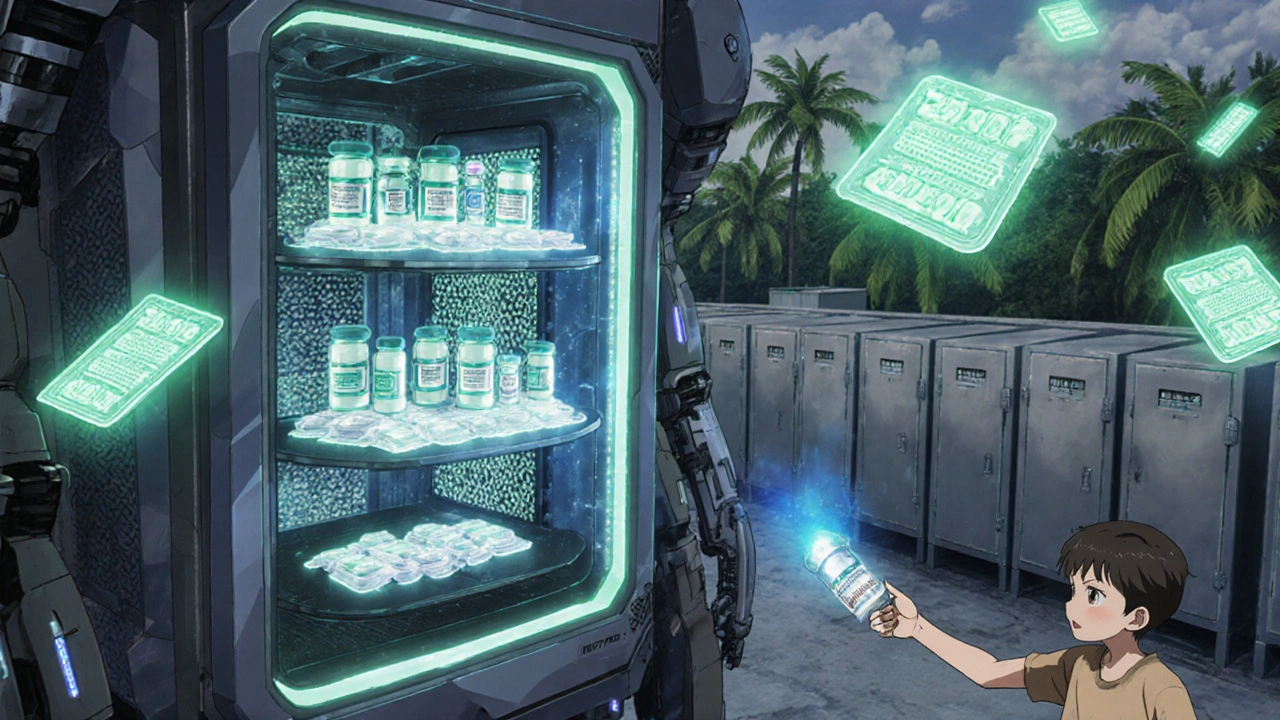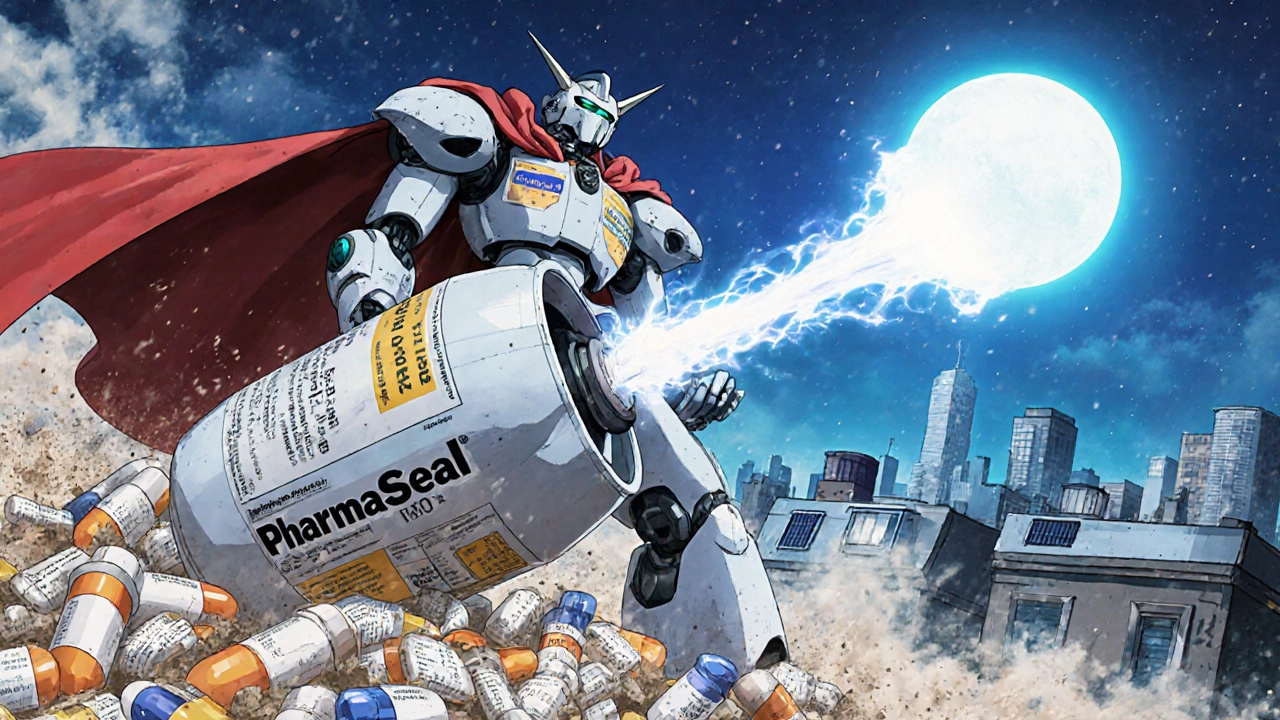
When you’re traveling to a tropical destination or living in one, your medications aren’t safe just because they’re sealed in a bottle. High heat and humidity can quietly destroy pills, capsules, and inhalers - reducing their potency, changing how they work, or even making them unsafe. This isn’t theoretical. In places like Southeast Asia, sub-Saharan Africa, or the Caribbean, up to 30% of medications degrade before reaching patients, according to the World Health Organization. For someone relying on antibiotics, insulin, or asthma inhalers, that’s not just inconvenient - it’s life-threatening.
Why Humidity Kills Medications
Medications aren’t designed to handle moisture the way your coffee mug is. When humidity hits 70% or higher - common in tropical climates - water molecules start breaking down the chemical structure of drugs. This process is called hydrolysis, and it’s responsible for about 70% of all moisture-related drug failures. Take lamotrigine, a common epilepsy drug: just four weeks at 75% humidity can cut its effectiveness by nearly a third. Amoxicillin, one of the most widely used antibiotics, can absorb up to 10% of its own weight in water under those conditions, losing half its potency in 30 days.
It’s not just chemistry. Physical changes happen too. Tablet coatings crack, pills stick together in a sticky mess, and capsules soften until they burst. Dry powder inhalers - critical for asthma and COPD - become useless when moisture causes the powder to clump. Freeze-dried vaccines? They’ll spoil if humidity rises above 20%. Even your daily multivitamin can turn into a hard, unusable lump if left in a steamy bathroom.
Which Medications Are Most at Risk?
Not all drugs are equally vulnerable. Some are far more sensitive to moisture than others. Here’s what to watch out for:
- Antibiotics like tetracycline, amoxicillin, and doxycycline degrade rapidly in humidity, sometimes changing color or smell. Tetracycline can lose effectiveness 3.5 times faster at 75% RH than at 40%.
- Antifungals such as fluconazole and itraconazole are hygroscopic - they suck up moisture like a sponge, which alters how they dissolve in your body.
- Orally disintegrating tablets (ODTs) like Zofran or Rizatriptan can take 5 times longer to dissolve in high humidity, meaning they won’t work when you need them.
- Dry powder inhalers (e.g., Advair, Symbicort) lose fine particle delivery by 15-25% when exposed to humidity above 40% RH. That’s the difference between getting your full dose and getting nothing.
- Insulin and biologics require refrigeration and must stay below 60% RH. Condensation can ruin them even if they’re cold.
- Pediatric formulations - syrups, chewables, and suspensions - often contain sugars and binders that attract moisture and encourage mold growth.
According to a 2023 survey of 1,200 pharmacists across tropical regions, antibiotics were the most commonly reported degraded medications (42%), followed by antifungals (29%) and pediatric drugs (24%).
What’s the Right Storage Environment?
For most medications, the ideal storage conditions are simple: 30-45% relative humidity and 15-25°C (59-77°F). That’s cooler and drier than most tropical homes or hotel rooms. The WHO says ‘controlled room temperature’ means below 30°C and 65% RH - but that’s the bare minimum. For real safety, aim lower.
Temperature matters too. Every 10°C rise above 25°C doubles the rate of chemical degradation. So a pill stored at 35°C (95°F) degrades twice as fast as one at 25°C (77°F). And if it’s both hot and humid? That’s a double hit.
Light also plays a role. About 65% of drugs are sensitive to UV light. That’s why amber bottles are used for many prescriptions - they block 90% of harmful rays. Clear plastic bottles? They offer almost no protection.

How to Protect Your Medications on the Go
If you’re traveling, don’t rely on hotel room storage. Bathrooms are the worst place - humidity regularly hits 80-95%. Instead:
- Use airtight containers - Glass jars with rubber seals or hard plastic pill cases with tight lids work better than ziplock bags. Avoid flimsy plastic bottles.
- Add silica gel desiccants - These little packets absorb moisture. Use 1-2 grams per 100 mL of container space. Replace them every 30 days in humid climates. You can buy them online or salvage them from new shoeboxes or electronics packaging.
- Keep meds away from windows and heat sources - Don’t leave them on a windowsill, near a fan, or in a car. Even a hot car in the shade can hit 40°C.
- Use humidity indicator cards - These cost less than $1 each and change color when humidity rises above 55%. Blue means dry. Pink means danger.
- Carry a small digital hygrometer - A $15 device that shows real-time humidity and temperature lets you know if your storage spot is safe. Look for models with ±2% RH accuracy.
For longer trips or if you’re living in a tropical area, consider a dry cabinet. Devices like the SMT DryBox maintain 5-15% RH and ±0.5°C stability. They’re expensive ($2,500-$15,000), but for insulin, vaccines, or chronic condition meds, they’re worth it. Some clinics in rural areas use low-cost alternatives - like modified metal cabinets with 5kg silica gel canisters - that keep humidity at 35-45% for under $120.
Advanced Solutions: What’s New in Packaging
Pharmaceutical companies are finally catching up. Since 2019, new blister packs with integrated moisture-scavenging polymers - like Aptar’s Activ-Polymer™ - have become standard for tropical markets. These don’t just block moisture; they actively pull it out of the air inside the package, keeping humidity below 20% for up to two years. The Gates Foundation has distributed over 500 million of these blister packs across Africa since 2021, cutting degradation by 58%.
Even the caps on bottles are getting smarter. New moisture-trapping caps with polymer linings reduce humidity inside the bottle by 90% for 18 months. And researchers at MIT are testing graphene oxide coatings - thinner than a human hair - that block 99.7% of moisture compared to standard aluminum foil. These won’t be in pharmacies yet, but they’re coming fast.
The WHO’s ‘PharmaSeal’ system - a reusable desiccant canister that lasts six months and costs just $0.85 - is now used in 32 countries. It’s simple, affordable, and works. Community health workers in the Philippines use a ‘30-30 Rule’: replace desiccants every 30 days if the temperature is above 30°C. That simple practice reduced spoilage by 47% in a 2022 trial with 15,000 patients.

What to Do If You Suspect Your Medication Is Damaged
Signs of degradation include:
- Change in color (yellowing, darkening, fading)
- Change in texture (sticky, crumbly, swollen, or discolored pills)
- Unusual smell (musty, sour, or chemical odor)
- Tablets that don’t dissolve properly
- Inhalers that feel clogged or don’t spray properly
If you see any of these, don’t take the medication. Even if it looks mostly okay, you can’t tell how much potency is left. In some cases, degraded antibiotics can cause antibiotic resistance. Degraded insulin can fail to lower blood sugar - with deadly results.
Always carry a backup supply of critical meds. If you’re unsure, ask a pharmacist in the country you’re in. Many tropical cities have pharmacies that specialize in international travel meds and can test samples or recommend replacements.
Regulations and Why This Matters
Drug manufacturers are required by the FDA, EMA, and ICH to test their products under tropical conditions (30°C/75% RH) before selling them in those markets. But that’s for the factory - not your suitcase. Once a pill leaves the controlled environment of a pharmacy, it’s on you.
Non-compliance isn’t just a regulatory issue - it’s a public health crisis. In 2020, Novartis recalled 15,000 units of its anti-malarial drug Coartem in Nigeria because humidity had degraded it. The recall cost over $7 million. And that’s just one case. The WHO estimates that humidity-related medication failures cost global health systems $1.2 billion every year.
That’s why the ICH is developing new guidelines - Q1H - specifically for tropical storage. Expected in 2025, they’ll make it mandatory for all new drugs targeting humid regions to prove they stay stable under real-world tropical conditions. Until then, you have to be your own guardian.
Final Checklist: Your Tropical Medication Survival Kit
Before you leave for a tropical trip, pack this:
- Original prescription bottles (don’t transfer to pill organizers unless they’re airtight)
- 2-3 silica gel packets per medication container
- A small digital hygrometer/thermometer
- Humidity indicator cards (blue-to-pink type)
- One airtight hard-shell container for daily meds
- Extra supply of critical meds (at least 10% more than you think you’ll need)
- Photo or copy of your prescription in case you need to replace meds abroad
Store your meds in a cool, dry, dark place - not the bathroom, not the car, not the bedside table near the window. A closet shelf in the middle of the room is usually safest.
Can I store my medications in the fridge in a tropical country?
Only if the medication requires refrigeration - like insulin or certain vaccines. For most pills and capsules, fridge storage isn’t recommended because condensation can form when you take them out, introducing moisture. If you do refrigerate, keep them in a sealed container with desiccant to prevent condensation.
Are silica gel packets reusable?
Yes, but only if you dry them out. Place used silica gel packets in an oven at 120°C (250°F) for 2-3 hours to reactivate them. Let them cool completely before reusing. Don’t microwave them - they can overheat and burst.
Do all pharmacies in tropical countries know about humidity risks?
Not always. Many local pharmacies don’t have climate-controlled storage. Ask if they keep medications in air-conditioned back rooms. If they store them on open shelves near windows or doors, be cautious. Look for international chains or hospitals - they’re more likely to follow proper standards.
What if I can’t find desiccants where I am?
Use uncooked rice as a temporary fix. Place your meds in a sealed container with a small cup of rice. Rice absorbs moisture slowly and can help for a few days. It’s not as effective as silica gel, but it’s better than nothing. Replace the rice every 3-5 days.
Is it safe to take degraded medication if it looks okay?
No. Even if it looks fine, degradation can be invisible. A pill might still look white and hard, but its active ingredient could be 50% weaker. Taking underdosed antibiotics can lead to treatment failure and antibiotic resistance. Always err on the side of caution.

Kihya Beitz
November 15, 2025 AT 09:47Wow, another ‘how to not die in the tropics’ guide. I’m sure the WHO really needed 10 pages on silica gel packets. My cousin took her insulin to Bali in a ziplock and lived to tell the story. Maybe we should all just stop taking meds and pray to the humidity gods?
Jennifer Walton
November 17, 2025 AT 03:44Medication stability is a quiet collapse. We assume containers are fortresses. They are not. The body doesn’t know the difference between 95% potency and 47%. It just stops working.
Jonathan Dobey
November 18, 2025 AT 10:40Let’s be real - this whole ‘tropical degradation’ thing is a Big Pharma psyop. They want you to buy $2,500 dry cabinets so you never question why your $5 antibiotic costs $120 in the US. The real enemy? The patent system that locks life-saving chemistry behind corporate vaults while people in Lagos die because their pills turned to chalk. And now we’re being sold silica gel as salvation? Pathetic. The real solution is universal access - not better packaging for the rich.
Also, graphene oxide coatings? That’s not innovation - that’s a military tech spinoff. They’ve been using this stuff in drone batteries since 2018. Why is it only ‘coming soon’ for your grandma’s blood pressure pills? Coincidence? I think not.
ASHISH TURAN
November 19, 2025 AT 05:14This is actually very useful. In India, we see this every monsoon - pills stick together, inhalers clog, and no one tells you. I always carry extra desiccants in my travel kit now. The rice trick works in a pinch, but silica gel is better. Also, never store meds in your backpack near your water bottle - condensation is silent killer.
Ryan Airey
November 20, 2025 AT 17:34Anyone who stores meds in a bathroom deserves what they get. But let’s cut the fluff - if your country can’t even control humidity in pharmacies, stop pretending you’re a ‘developed’ healthcare system. This isn’t a ‘travel tip’ - it’s a systemic failure. And the WHO’s $0.85 canister? That’s a Band-Aid on a hemorrhage. Fix the supply chain, not the pill bottle.
Hollis Hollywood
November 21, 2025 AT 08:15I just want to say how much this post resonates with me. I’ve had family members in Puerto Rico lose their insulin after a hurricane, and the local pharmacy had no climate control. It’s terrifying. I didn’t even know about humidity indicator cards until now. I’m going to buy a hygrometer tomorrow. It’s crazy that something so simple - monitoring moisture - isn’t standard practice everywhere. We treat our phones better than our medicine. I feel like this is the kind of thing we should be teaching in schools. Not just for travelers, but for everyone living in humid places. It’s not just about convenience - it’s about dignity. You shouldn’t have to be a scientist just to stay alive.
Andrew Eppich
November 22, 2025 AT 11:55Storing medications improperly is irresponsible. If you are unable to maintain basic environmental controls for your prescriptions, you should not be traveling. This is not a niche concern - it is a medical imperative. The fact that people rely on rice or ziplock bags shows a dangerous lack of preparedness. Your life is not a DIY experiment.
Jessica Chambers
November 23, 2025 AT 05:31Just bought a dry cabinet after reading this 😅 I used to keep my asthma inhaler next to my shower… yikes. Also, silica gel packets in my purse now. No more ‘I think it’s still good’ moments. 🙏
Shyamal Spadoni
November 23, 2025 AT 23:45ok so i read this whole thing and like 70% of it made sense but then i got lost when they talked about graphene oxide and like why is the gatess foundation even involved in pills? like who is really controlling this? i mean if you think about it the whole pharma industry is built on fear right? like if your pills didnt degrade then why would you keep buying them? and why are all the new solutions so expensive? like a $15 hygrometer? come on. and what about the people who live in villages with no electricity? they just die? or do they? i think there’s a bigger story here about who gets to live and who gets to be told how to store their medicine. also i think the WHO is part of the problem because they always say ‘controlled room temp’ but what does that even mean? like in a shack with no AC? i think this whole thing is a distraction from the real issue: why are life saving drugs so fragile? and why dont we make them like… bulletproof?
Ogonna Igbo
November 25, 2025 AT 17:53Why are you telling Africans how to store medicine? We’ve been living with humidity for centuries. Our grandmothers used clay pots and dried leaves. We didn’t need silica gel or MIT coatings. Now you come with your $2500 dry cabinets and talk about ‘degradation’ like we’re children. The real problem is not humidity - it’s that your expensive drugs were never designed for us. Stop treating us like lab rats with poor storage habits. Fix the drug itself. Don’t make us carry your corporate failures in our pockets.
BABA SABKA
November 27, 2025 AT 09:56Let’s cut through the jargon - this isn’t about ‘hydrolysis’ or ‘RH thresholds’. It’s about access. The fact that you need a $15 digital hygrometer to survive on a tropical island means the system is broken. In Nigeria, we don’t have the luxury of ‘ideal storage’. We have a fan, a shelf, and hope. The real innovation isn’t graphene or Aptar’s magic polymer - it’s making drugs that don’t need climate control in the first place. If your medicine can’t survive 35°C and 80% humidity without a $15,000 cabinet, then it shouldn’t be on the market. Period. Pharma needs to engineer for the real world - not the lab.